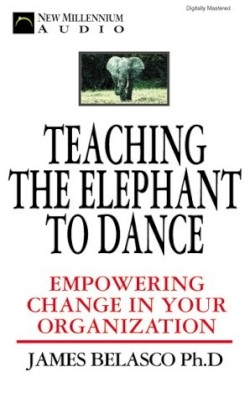
Teaching the Elephant to Dance
“Organizations are like elephants-slow to change,” begins best-selling author,
consultant, and teacher James A. Belasco on this audiotape. Using metaphors like flow charts, Belasco endeavors to teach CEOs how to create a business atmosphere that humanizes the boardroom.
“Trainers shackle young elephants with heavy chains to deeply embedded stakes? As time passes, the elephant learns to stay in its place and change does not occur.” Belasco lauds change as the only means to corporate survival. He uses examples of highly visible companies like Xerox, a firm that rode the tide of success to the brink of disaster because key players refused to “take Japanese competition seriously.”
Belasco’s three hours of intensive training sessions include a change process: “build a sense of urgency, create a clear tomorrow, develop a migration path, and reinforce the new behavior.” After each training section, the author speeds into a workshop that reinforces the material.
“Establish the urgency to change without destroying employee self-confidence,” he recommends. CEOs and top managers are reminded that the lifeblood of the corporation is the people it employs. He recounts a story about the CEO of McDonald’s in which Ray Crock, dressed in an expensive business suit, got down on his hands and knees with one of the young McDonald’s franchise managers to pick up trash lodged in the shrubbery.
Although buzzwords of the past decade echo through Belasco’s dance, his defining message of vision-creating clear goals and modeling behavior for employees-are good strategy-building techniques for any millennium. The vision for the company is made clear to each employee. The knees of business suits are dirtied in order to show common ground. The company becomes important to the employee because the employee knows that he’s important to the company.
Teaching the Elephant to Dance is no slow-moving waltz, but a high-energy jitterbug. There isn’t time to think before another tune begins, and the next dance is one to be analyzed and studied. With this in mind, a manager looking to follow Belasco’s strategies might benefit from purchasing the book along with the audiotape.
“What’s the bottom-line impact this quarter?” asks Belasco. The bottom line impact of Teaching the Elephant to Dance is that continuous change and an earnest show of common ground will help any organization to succeed.
Disclosure: This article is not an endorsement, but a review. The publisher of this book provided free copies of the book to have their book reviewed by a professional reviewer. No fee was paid by the publisher for this review. Foreword Reviews only recommends books that we love. Foreword Magazine, Inc. is disclosing this in accordance with the Federal Trade Commission’s 16 CFR, Part 255.
